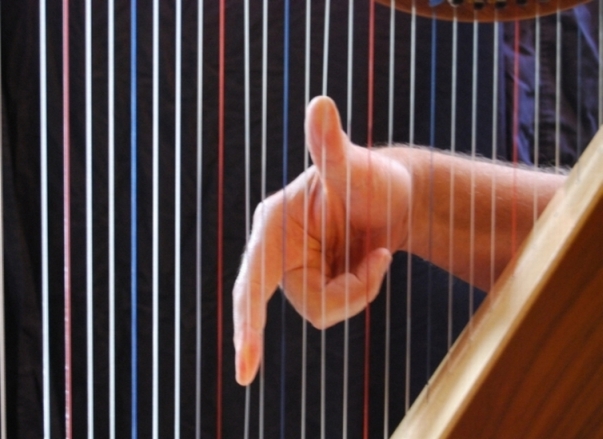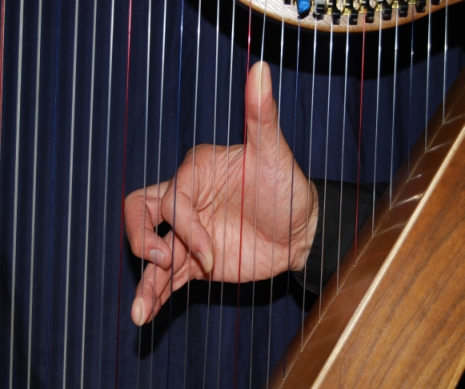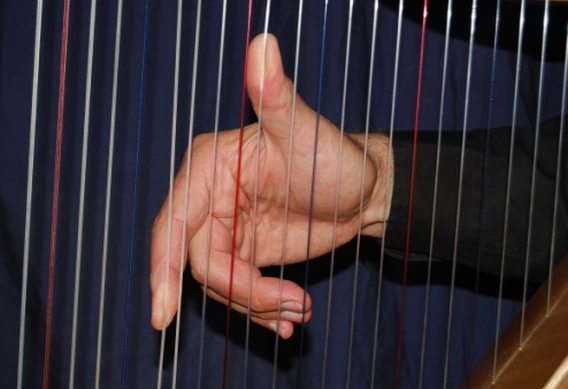Page 2
STEP-BY-STEP TUNING GUIDE
SETTING THE TEMPERAMENT FOR A HARP TUNED TO C
(I always tune my harp to C. I like to avoid levers as much as possible, because I think open strings sound a lot better than levered strings. Of course, that's my opinion, and I know a great many Celtic harpists tune to Eb. To tune to Eb, follow this page and the next page through STEP 8, and then choose the link to go to the Eb tuning.)
STEP 1. A TO D (Down a 5th)
You've already found A440, so it's time to find the next string. Go down a fifth to the D below A440. ( See Figure Below)

As you adjust the string with the tuning wrench, find the spot where there are no beats. Beats are more difficult to hear on a harp than a piano. Listening for them involves concentration. The ability to hear these beats is not something that only a few virtuosos can do. If you listen carefully enough you will hear them. If you're having trouble here, email me on this site, and I'll give you more tips. After you have learned to eliminate the beats, tighten the string just a bit, thus creating the beats again. Flatten the string (loosen it) until you can hear about one beat per second. When this happens, you've successfully completed your first two notes. By keeping this beat, you have made sure that the D is slightly sharp, thus making a contracted fifth.
There is one important thing to note here: Always tune sharp and then fall back into place. There are two reasons for this. The first is that the string will stay in place better if you tune it (slightly) sharp and then let it fall into place. We call this setting the strings. The second reason is that you're going to be in a lot of trouble if you listen for the one beat per second, but don't notice that you're slightly flat instead of sharp.
STEP 2. A TO A an octave below

No compromising here— tune the two strings perfectly in tune. Tune the low A slightly sharp, and then fall back into a perfect octave tuning.
STEP 3. A D and A Comparison
Now we come to a system that I discovered when tuning pianos. No one taught me this, but I've found it to be the best possibly way to tune. The A440, A220, and D in the middle have a dynamic relationship. D to high A is a perfect fifth, and D to low A is a perfect fourth. Now tune the D with the A above, and if you want it to be in the right place, check it with the A below as well.
 There's only one place in the adjustment that you will find both the fourth and the fifth satisfactory. If your listening for the single beat per second was not quite accurate, you'll find out now, and not several strings down the line (and then have to start all over). Most piano tuners tune a single octave and call it "setting the temperament". After that you're simply tuning octaves. But I set my temperament over two octaves using this system. It's much easier, and is full of checks and balances.
There's only one place in the adjustment that you will find both the fourth and the fifth satisfactory. If your listening for the single beat per second was not quite accurate, you'll find out now, and not several strings down the line (and then have to start all over). Most piano tuners tune a single octave and call it "setting the temperament". After that you're simply tuning octaves. But I set my temperament over two octaves using this system. It's much easier, and is full of checks and balances.
You've now tuned three strings, and determined that the D between to A's is in the right place. Go up an octave from the D you tuned, and tune those two strings perfectly in tune. Now check your newly tuned high D with the A440 below it. Does that 4th sound OK? If so, you're on a roll— keep on moving.
STEP 4. D Down to G (Down a 5th)
Next we go to the G between the two D's.

Tune it with the D above. Remember you want to tune the 5th first, making it sharp and then falling back in place (please remember that when I say to sharpen the interval I mean only a very small amount). When the high D and G are tuned, then compare the G with the D below. Are you keeping down to about a beat per second? Do they have a nice sound? Be careful of listening for a "perfect" perfect fifths and fourths. You will yearn for that sound, but you must remember that the fifth must be slightly out of tune.
STEP 5. G TO G an octave below
(No picture)Tune the G below and use the same procedure. Tune the octave, and then check it with the D above.
 There's only one place in the adjustment that you will find both the fourth and the fifth satisfactory. If your listening for the single beat per second was not quite accurate, you'll find out now, and not several strings down the line (and then have to start all over). Most piano tuners tune a single octave and call it "setting the temperament". After that you're simply tuning octaves. But I set my temperament over two octaves using this system. It's much easier, and is full of checks and balances.
There's only one place in the adjustment that you will find both the fourth and the fifth satisfactory. If your listening for the single beat per second was not quite accurate, you'll find out now, and not several strings down the line (and then have to start all over). Most piano tuners tune a single octave and call it "setting the temperament". After that you're simply tuning octaves. But I set my temperament over two octaves using this system. It's much easier, and is full of checks and balances.

